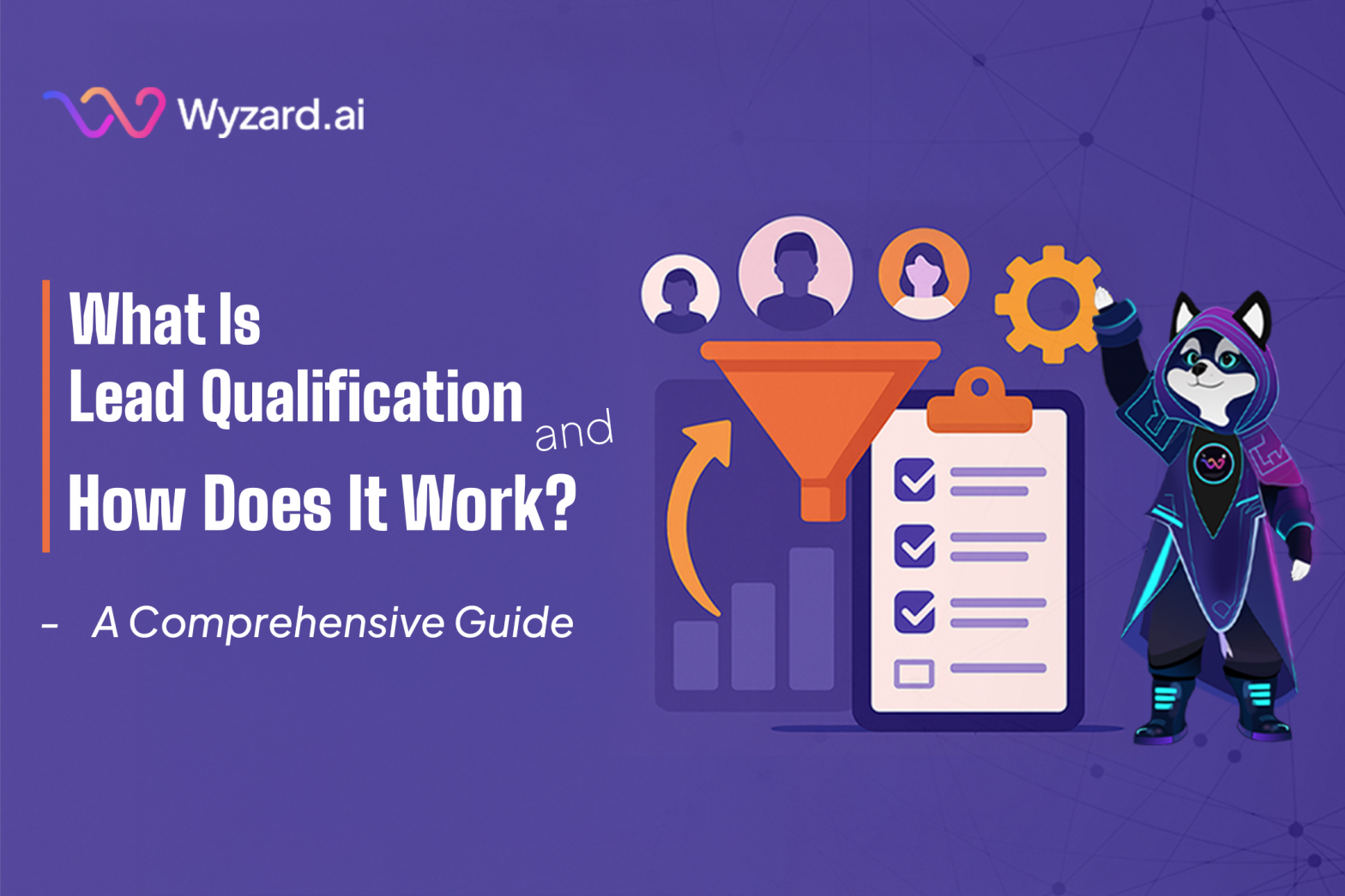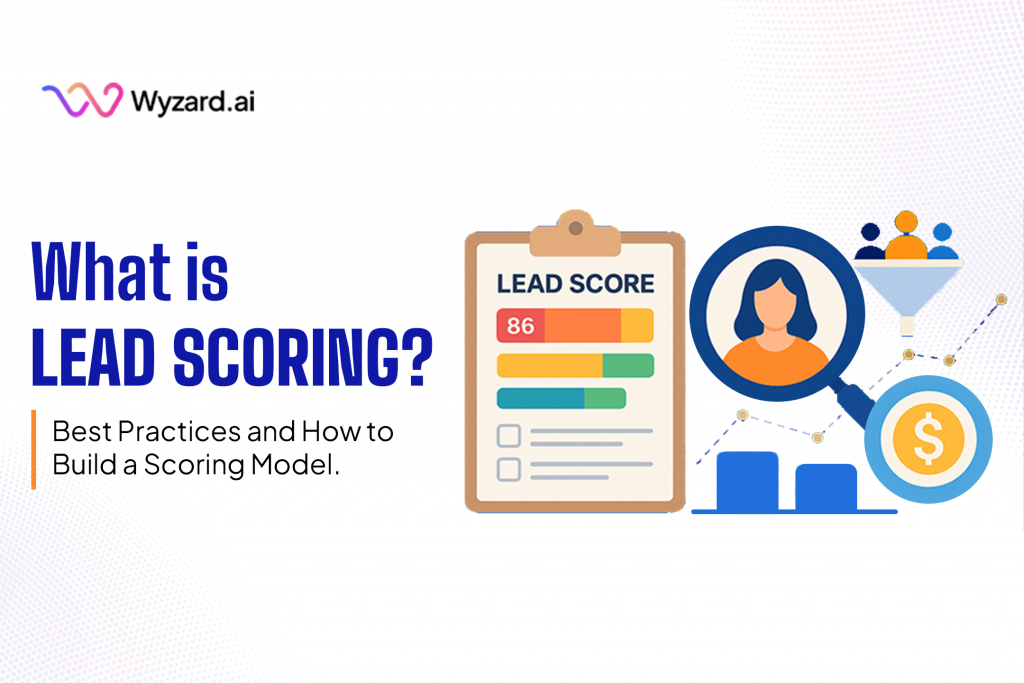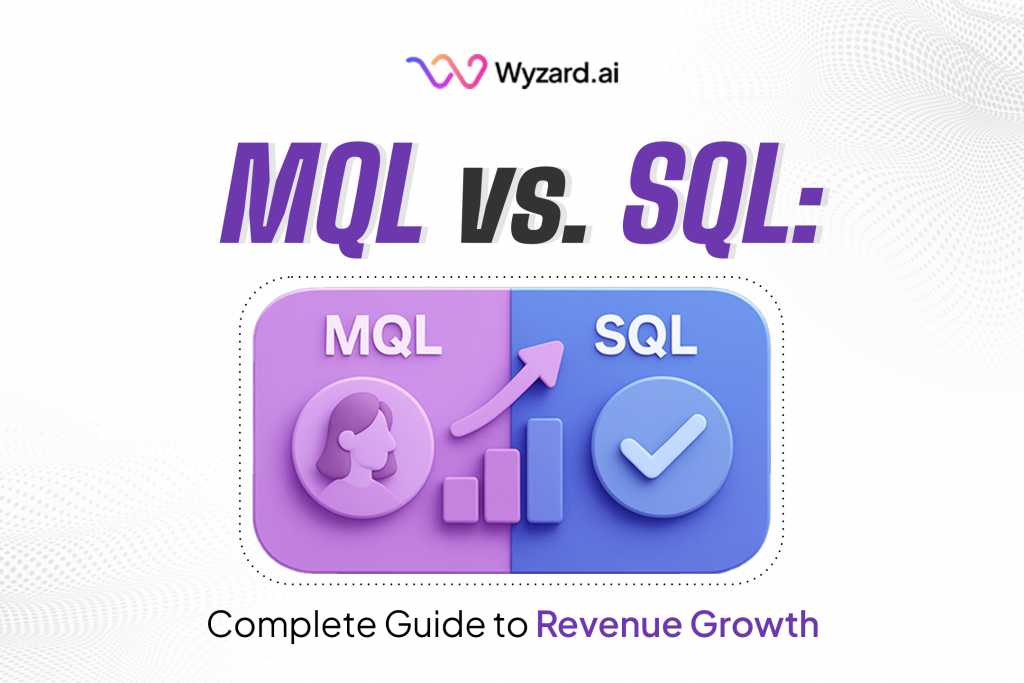How a West‑coast debut, record attendance, and a surge of AI innovation set the stage for Wyzard.ai’s biggest ...
What Is Lead Qualification and How Does It Work? A Comprehensive Guide


Subscribe Now
80% of sales teams waste time chasing leads that were never going to buy. Meanwhile, qualified prospects slip through the cracks. The difference? Systematic lead qualification versus gut feelings and generic follow-ups.
What is Lead Qualification?
Lead qualification determines whether a prospect has the characteristics, intent, and capacity to become a paying customer. Unlike basic contact collection, qualification evaluates budget availability, decision-making authority, genuine need for your solution, and realistic purchase timeline.
Effective sales lead qualification separates prospects worth pursuing from those requiring additional nurturing or elimination entirely. Without qualification, sales teams waste resources on poor-fit prospects while high-potential opportunities receive inadequate attention.
Modern lead qualification extends beyond demographic matching to include behavioral analysis, intent signal detection, and engagement pattern evaluation. Prospects who visit pricing pages multiple times demonstrate higher qualification than those consuming only general educational content.
Lead Scoring vs. Lead Qualification
Lead qualification and lead scoring serve different but complementary purposes in prospect evaluation. Lead scoring assigns numerical values based on prospect characteristics and behaviors, while lead qualification determines readiness for sales engagement.
Lead scoring operates continuously, automatically adjusting prospect ratings as new information becomes available. Sales lead qualification typically occurs at specific handoff points when prospects transition from marketing to sales teams.
Scoring helps prioritize prospects for qualification efforts, while qualification determines appropriate next steps and resource allocation. Both processes work together to optimize sales team efficiency and conversion probability.
The Importance of Lead Qualification
Lead qualification transforms sales operations from reactive prospect chasing to strategic opportunity pursuit. Understanding qualification importance helps justify process investment and team training requirements.
Save Time & Resources
Proper lead qualification processes eliminate wasted effort on prospects lacking genuine purchase intent or capability. Sales representatives can focus attention on qualified opportunities instead of educating unqualified prospects about basic concepts.
Qualification also prevents premature sales pressure on prospects requiring additional nurturing. Pushing unqualified prospects toward purchase decisions often accelerates their exit from your sales funnel entirely.
Improved Customer Experience
Lead qualification ensures prospects receive appropriate attention levels and communication approaches. Qualified prospects get immediate sales engagement while others enter educational nurturing sequences that build trust gradually.
Mismatched engagement levels frustrate both prospects and sales teams. Qualified buyers expect prompt, knowledgeable responses while unqualified prospects feel pressured by aggressive sales approaches.
Higher Conversion Rates
Systematic sales lead qualification dramatically improves conversion rates by focusing sales efforts on prospects most likely to purchase. Qualified prospects convert at significantly higher rates than unfiltered lead pools.
Smart lead qualification approaches can increase sales velocity by ensuring representatives spend time on opportunities with genuine closing potential rather than prospects requiring extensive education.
Better Use of Marketing Resources
Lead qualification helps marketing teams understand which activities generate genuinely qualified prospects versus high-volume, low-quality leads. Resource allocation improves when teams know which campaigns produce sales-ready opportunities.
Marketing automation efforts become more effective when qualification criteria guide nurturing workflows. Prospects move through appropriate sequences based on qualification levels rather than generic timelines.
Improved Bottom Line
Effective lead qualification processes directly impact revenue generation by improving sales efficiency and conversion rates. Teams close more deals with fewer resources while shortening average sales cycles.
Qualification also reduces customer acquisition costs by eliminating wasteful pursuit of unqualified prospects. Sales teams achieve better results with existing headcount and resources.
Helps Sales Teams Meet Targets
Sales lead qualification provides predictable pipeline visibility that helps representatives and managers forecast performance accurately. Qualified pipeline quality enables realistic goal setting and achievement planning.
Teams with systematic qualification processes experience less end-of-quarter desperation and more consistent performance throughout entire sales periods.
How Lead Qualification Works
Lead qualification combines automated data collection with human evaluation to assess prospect readiness and fit. Modern processes integrate technology tools with proven qualification frameworks for comprehensive assessment.
Automated systems capture behavioral data, demographic information, and engagement patterns while human team members conduct qualification conversations and evaluate complex situations requiring judgment.
Lead qualification isn’t a one-time checkpoint, it’s a living process. Smart AI systems track prospects 24/7, instantly adjusting scores as behaviors change, new stakeholders emerge, or buying signals strengthen. No human delays.
The Lead Qualification Process
Lead qualification processes follow systematic approaches that ensure consistent evaluation across all prospects and team members. Standardized processes prevent qualified opportunities from slipping through evaluation gaps.
Initial qualification begins with automated data collection and behavioral tracking. Prospects demonstrate qualification through specific actions like pricing page visits, demo requests, or detailed product inquiries.
Human qualification conversations verify automated assessments while gathering additional information about budget, authority, timeline, and genuine need. Structured qualification frameworks guide conversations and information collection.
Benefits of Lead Scoring
Lead scoring supports lead qualification by providing quantitative prospect assessments that guide prioritization and resource allocation decisions.
Better Productivity
Lead scoring automatically identifies prospects deserving immediate attention versus those requiring additional nurturing. Sales teams focus efforts on highest-scoring prospects while marketing continues developing lower-scoring opportunities.
Scoring also eliminates manual prospect evaluation time, allowing representatives to spend more time on actual selling activities rather than research and assessment.
More Personalization
Lead scoring data enables personalized communication approaches based on prospect characteristics and engagement patterns. High-scoring prospects receive different messaging than early-stage researchers.
Behavioral scoring reveals prospect interests and concerns that guide conversation topics and content recommendations. Personalized approaches significantly improve engagement and conversion rates.
Keep Marketing & Sales Aligned
Lead scoring creates shared prospect assessment criteria that align marketing and sales team expectations. Both teams understand what constitutes qualified prospects and appropriate handoff timing.
Scoring also provides feedback loops that help marketing teams understand which activities generate genuinely qualified prospects versus high-volume, low-quality leads.
Types of Qualified Leads
Lead qualification creates distinct prospect categories that receive appropriate treatment and resource allocation. Understanding lead types helps teams design proper workflows and expectations.
Information Qualified Leads (IQLs)
Information Qualified Leads demonstrate initial interest by consuming educational content or requesting basic information. IQLs require nurturing rather than immediate sales engagement.
IQL qualification criteria include content downloads, newsletter subscriptions, or general inquiry submissions. Prospects demonstrate interest but haven’t indicated readiness for purchase conversations.
Marketing Qualified Leads (MQLs)
Marketing Qualified Leads exhibit increased engagement and demonstrate characteristics matching ideal customer profiles. MQLs show progression beyond casual interest toward genuine evaluation.
MQL qualification requires multiple touchpoints, specific behavioral triggers, or demographic matching criteria. Marketing automation platforms track engagement patterns that indicate MQL status.
Sales-Ready Leads (SRLs)
Sales-Ready Leads demonstrate clear purchase intent through specific actions like demo requests, pricing inquiries, or competitor comparison activities. SRLs warrant immediate sales attention.
SRL identification relies heavily on behavioral triggers that indicate active evaluation processes. Prospects consuming solution-specific content signal readiness for sales conversations.
Sales Qualified Leads (SQLs)
Sales Qualified Leads pass human qualification conversations that verify budget, authority, need, and timeline. SQLs represent genuine opportunities worthy of full sales engagement.
SQL qualification requires direct prospect interaction and structured assessment using proven qualification frameworks. Human evaluation confirms automated assessments and gathers additional context.
Lead Qualification Frameworks & Methodologies
Lead qualification frameworks provide structured approaches that ensure consistent prospect evaluation and prevent important qualification factors from being overlooked.
BANT (Budget, Authority, Needs, Time)
BANT qualification assesses whether prospects have budget allocated, decision-making authority, genuine need for your solution, and realistic purchase timeline. BANT provides simple, memorable qualification criteria.
Budget qualification determines whether prospects have allocated funds or ability to acquire necessary resources. Authority assessment identifies decision-makers and influencers involved in purchase processes.
CHAMP (Challenges, Authority, Money, Prioritization)
CHAMP qualification begins with understanding prospect challenges before assessing other factors. Challenge identification helps determine solution fit and potential value.
Prioritization assessment determines whether solving identified challenges ranks high enough to warrant investment and implementation effort. Priority evaluation often predicts purchase likelihood better than budget availability.
ANUM (Authority, Needs, Urgency, Money)
ANUM prioritizes authority identification as the foundation for effective qualification. Without access to decision-makers, even well-qualified prospects rarely convert successfully.
Urgency assessment determines whether prospects have compelling reasons to act quickly versus delaying purchase decisions indefinitely. Urgency often drives purchase timing more than other factors.
GPCTBA/C&I (Goals, Plans, Challenges, Timeline, Budget, Authority)
GPCTBA/C&I provides comprehensive qualification criteria covering strategic goals, implementation plans, current challenges, realistic timelines, budget availability, and decision-making authority.
Challenge identification helps understand specific problems your solution addresses while goal assessment determines alignment between prospect objectives and your solution capabilities.
MEDDIC (Metrics, Economic Buyers, Decision Criteria, Decision Process, Identify Pain, Champion)
MEDDIC qualification works particularly well for complex B2B sales involving multiple stakeholders and evaluation criteria. MEDDIC identifies all factors influencing purchase decisions.
Economic buyer identification ensures access to individuals with budget authority and ultimate decision-making responsibility. Champion development creates internal advocates who promote your solution.
FAINT (Funds, Authority, Interest, Needs, Time)
FAINT replaces budget assessment with funds evaluation, recognizing that prospects can often acquire money when genuine interest and need exist. Fund availability differs from budget allocation.
Interest assessment determines emotional engagement levels that often predict purchase probability better than logical qualification criteria alone.
Essential Lead Qualification Information
Lead qualification requires specific information categories that provide comprehensive prospect assessment capabilities. Missing qualification data creates evaluation gaps that lead to poor prioritization decisions.
Audience Information
Audience information includes prospect demographics, job roles, responsibilities, and decision-making influence within target organizations. Role information helps determine appropriate communication approaches and content.
Industry experience and background information reveals prospect familiarity with your solution category and likely evaluation criteria. Experienced buyers often move faster through sales processes.
Business Information
Business information covers company size, growth stage, technology infrastructure, and competitive landscape factors that influence solution fit and implementation complexity.
Understanding business models, revenue sources, and operational priorities helps assess alignment between prospect needs and your solution capabilities.
Company Details
Company details include organizational structure, recent changes, growth plans, and strategic initiatives that might influence purchase timing and decision-making processes.
Merger and acquisition activity, leadership changes, or market expansion plans often create urgency for solution evaluation and implementation.
Interaction Information
Interaction information tracks all touchpoints between prospects and your organization including website visits, content consumption, email engagement, and direct communications.
Communication preferences and response patterns help optimize future outreach timing and channel selection for maximum engagement probability.
Engagement Data
Engagement data measures depth and frequency of prospect interactions with your content, website, and team members. Engagement patterns often predict qualification levels and purchase intent.
Progressive engagement increase typically indicates growing interest while declining activity suggests reduced priority or competitive displacement.
Online Activity
Online activity tracking reveals prospect research patterns, competitor evaluation, and solution comparison activities that indicate evaluation stage and purchase timeline.
Social media activity and professional networking engagement provide additional context about prospect priorities and decision-making processes.
Buyer’s Profile
Buyer profiles combine demographic, behavioral, and contextual information to create comprehensive prospect assessments that guide qualification decisions and sales approaches.
Profile development requires ongoing information gathering and updating as prospect circumstances and engagement patterns evolve over time.
Lead Qualification Questions
Lead qualification conversations require strategic questioning that uncovers essential assessment information without creating interrogation experiences that discourage prospect engagement.
Budget-Related Questions
Budget qualification determines financial capacity and allocated resources for your solution category. Budget discussions require sensitivity to avoid premature price objections.
“What budget range are you considering for addressing this challenge?” opens budget conversations without demanding specific amounts. “How do you typically approach investments in this area?” reveals budgeting processes.
Authority Questions
Authority assessment identifies decision-makers, influencers, and approval processes that affect purchase decisions. Authority questions must respectfully navigate organizational hierarchies.
“Who else would be involved in evaluating a solution like this?” identifies other stakeholders. “What does your typical evaluation process look like?” reveals decision-making workflows.
Need Assessment Questions
Need assessment questions uncover specific problems your solution addresses and determine urgency levels for resolution. Need qualification requires understanding both explicit and implicit challenges.
“What prompted you to start looking at solutions in this area?” reveals triggering events. “How are you currently handling this challenge?” identifies existing approaches and pain points.
Timeline Questions
Timeline qualification determines realistic purchase schedules and implementation requirements. Timeline discussions help prioritize opportunities and resource allocation.
“When do you need to have a solution in place?” establishes deadline requirements. “What factors might influence your timeline?” identifies potential delays or acceleration opportunities.
Steps to Enhance Lead Qualification
Lead qualification processes require continuous optimization based on performance data and changing market conditions. Enhancement efforts improve qualification accuracy and sales team effectiveness.
Define Lead Qualification Characteristics
Clear qualification criteria eliminate subjective assessments that create inconsistent prospect evaluation across team members. Written criteria provide training foundations and performance measurement standards.
Regular criteria review ensures qualification standards remain relevant as products, markets, and customer profiles evolve. Outdated criteria often miss qualified prospects or include poor-fit opportunities.
Automate the Process
Automation handles routine qualification tasks while preserving human involvement for complex assessment situations. Automated systems operate consistently without fatigue or bias.
AI-powered qualification systems analyze behavioral patterns and demographic data to identify qualified prospects faster than manual evaluation processes.
Continuously Review Your Process
Regular lead qualification process reviews identify optimization opportunities based on actual conversion results and team feedback. Process improvement requires ongoing attention rather than one-time setup.
Quarterly reviews help identify seasonal patterns, market changes, or competitive factors that influence qualification criteria effectiveness.
Use the Right Technology
Technology selection significantly impacts lead qualification effectiveness and team adoption rates. Right technology integrates seamlessly with existing workflows while providing enhanced capabilities.
Technology stack consolidation often improves qualification data quality by reducing information silos and integration challenges.
Lead Qualification With CRM Technology
Lead qualification capabilities improve dramatically when integrated with comprehensive CRM systems that centralize prospect information and automate qualification workflows.
Centralized Information Management
CRM systems consolidate all prospect interactions, behavioral data, and qualification assessments in single locations accessible to entire teams. Centralization eliminates information gaps that compromise qualification accuracy.
Historical interaction data provides context for current qualification assessments and helps identify prospect progression patterns that predict purchase likelihood.
Email Management
CRM email integration tracks all prospect communications while enabling personalized outreach based on qualification levels and engagement patterns. Email automation supports nurturing workflows for different qualification categories.
Response tracking and engagement measurement provide behavioral data that influences ongoing qualification assessments and prioritization decisions.
Lead Prioritization
CRM lead scoring and prioritization features automatically rank prospects based on qualification criteria and behavioral indicators. Prioritization helps sales teams focus attention on highest-potential opportunities.
Dynamic prioritization adjusts prospect rankings as new information becomes available, ensuring current qualification assessments drive resource allocation decisions.
Data Sharing
CRM systems enable seamless information sharing between marketing and sales teams, ensuring qualification assessments benefit from complete prospect interaction history.
Shared visibility prevents duplicate qualification efforts while ensuring all team members access current prospect assessment information.
Deal Progression
CRM opportunity management tracks qualification status throughout sales processes while identifying progression patterns that predict successful outcomes.
Stage progression tracking helps identify qualification gaps that prevent deal advancement and opportunities requiring additional nurturing.
Workflow Automation
Automated workflows ensure qualified prospects receive appropriate follow-up actions while unqualified prospects enter nurturing sequences. Automation eliminates qualification gaps caused by manual oversight.
Trigger-based workflows respond immediately to qualification events, ensuring prompt action when prospects demonstrate readiness for sales engagement.
Performance Tracking
CRM reporting capabilities measure lead qualification effectiveness through conversion tracking, sales cycle analysis, and team performance assessment.
Performance data enables continuous qualification process optimization based on actual results rather than theoretical assumptions.
Detecting and Managing Lead Quality
Lead qualification requires distinguishing genuine prospects from poor-quality leads that waste sales resources and distort performance metrics.
Identifying Genuine Prospects
Genuine prospects demonstrate consistent engagement patterns, provide accurate information, and respond appropriately to sales outreach efforts. Authentic prospects show progression through logical evaluation stages.
Multiple touchpoint verification helps confirm prospect legitimacy while inconsistent information or behavior patterns suggest potential quality issues.
Detecting Bots
Automated bot traffic can inflate lead volumes while providing no sales value. Bot detection requires analyzing behavior patterns that differ from genuine human engagement.
Rapid form completions, impossible navigation patterns, or generic response content often indicate automated rather than human activity.
Lead Scoring Implementation
Lead scoring algorithms help identify quality prospects based on engagement patterns and demographic alignment with ideal customer profiles. Scoring criteria should reflect actual conversion patterns rather than assumptions.
Regular scoring model optimization ensures continued accuracy as prospect behaviors and market conditions evolve over time.
Best Practices for Lead Qualification
Lead qualification excellence requires following proven practices that maximize qualification accuracy while maintaining efficient resource utilization.
Alignment Between Marketing and Sales
Marketing and sales team alignment ensures consistent qualification criteria and smooth prospect handoff processes. Misalignment creates qualification gaps and prospect experience problems.
Regular alignment meetings help identify qualification process improvements and resolve conflicts between marketing and sales perspectives on prospect readiness.
Continuous Process Improvement
Lead qualification processes require ongoing optimization based on performance data and market feedback. Static processes become less effective as business conditions evolve.
Monthly process reviews identify optimization opportunities while quarterly assessments evaluate broader strategic alignment and effectiveness.
Technology Integration
Integrated technology stacks provide comprehensive prospect visibility that improves qualification accuracy and team efficiency. Disconnected systems create information gaps that compromise assessment quality.
Modern AI marketing copilots can automate initial qualification while preserving human involvement for complex assessment situations.
Performance Measurement
Regular performance measurement ensures lead qualification efforts deliver expected results while identifying areas requiring improvement or additional resources.
Conversion tracking, sales cycle analysis, and customer feedback provide comprehensive assessment of qualification effectiveness and process quality.
Transform Your Lead Qualification with Wyzard
Traditional lead qualification processes rely heavily on manual assessment and delayed response times that miss critical engagement opportunities. Modern buyers expect immediate, intelligent responses when demonstrating purchase intent.
Manual qualification creates bottlenecks where high-intent prospects wait for human evaluation while competitors engage instantly. Companies lose significant revenue simply because qualified prospects receive delayed or generic responses.
AI marketing copilots transform sales lead qualification by engaging prospects immediately when they demonstrate qualification signals. Instead of waiting for manual evaluation, intelligent systems assess prospect behavior and initiate appropriate responses automatically.
With Wyzard’s Marketing Copilot, your lead qualification happens in real-time as prospects engage with your website and content. The AI identifies qualified prospects through behavioral analysis and initiates personalized conversations that gather qualification information naturally.
Ready to eliminate qualification delays and engage prospects when intent is highest? Book a demo and experience intelligent lead qualification that converts prospects while they’re actively evaluating solutions.
FAQ
Lead qualification is the systematic process of evaluating prospects to determine their likelihood of becoming paying customers. Qualification assesses budget availability, decision-making authority, genuine need, and realistic purchase timeline before allocating sales resources.
A lead qualification specialist evaluates prospects using structured frameworks and assessment criteria to determine sales readiness. Specialists conduct qualification conversations, analyze behavioral data, and prioritize prospects for appropriate sales or marketing attention.
Lead qualification in CRM involves using customer relationship management systems to automate qualification processes, track prospect assessments, and manage qualified leads through sales pipelines. CRM qualification combines automated scoring with human evaluation for comprehensive assessment.
Lead qualification factors typically include budget availability, decision-making authority, genuine need for your solution, purchase timeline, and fit with ideal customer profiles. Behavioral factors like engagement patterns and intent signals also influence qualification assessments.
A good lead qualification rate varies by industry and business model but typically ranges from 10-25% of total leads. Higher qualification rates often indicate better lead generation targeting while lower rates may suggest process improvement opportunities.
How to qualify a lead involves using structured frameworks like BANT or MEDDIC to assess prospect characteristics, conducting qualification conversations to gather assessment information, and analyzing behavioral data to confirm qualification status before sales engagement.
Lead level 2 typically represents moderate qualification in most scoring systems, indicating prospects requiring additional nurturing before sales engagement. Level 2 leads often enter automated nurturing sequences while higher-level prospects receive immediate sales attention.
Companies pay varying amounts for qualified leads depending on industry, solution value, and qualification level. Sales qualified leads typically cost more than marketing qualified leads but provide higher conversion probability and shorter sales cycles.
Other blogs
The latest industry news, interviews, technologies, and resources.
July 2, 2025
What Is Lead Scoring? Best Practices and How to Build a Scoring Model
Imagine Sarah from Acme Corp just downloaded your pricing guide, attended yesterday's product demo, and clicked "Talk to Sales", ...

July 1, 2025
MQL vs SQL: Complete Guide to Revenue Growth in 2025
You’re sitting on 500 fresh leads. But by month’s end, only 15 deals cross the finish line. It’s not ...

 Want to scale pipeline across web, email, ads and events? Grab the new GTM playbook
Want to scale pipeline across web, email, ads and events? Grab the new GTM playbook



